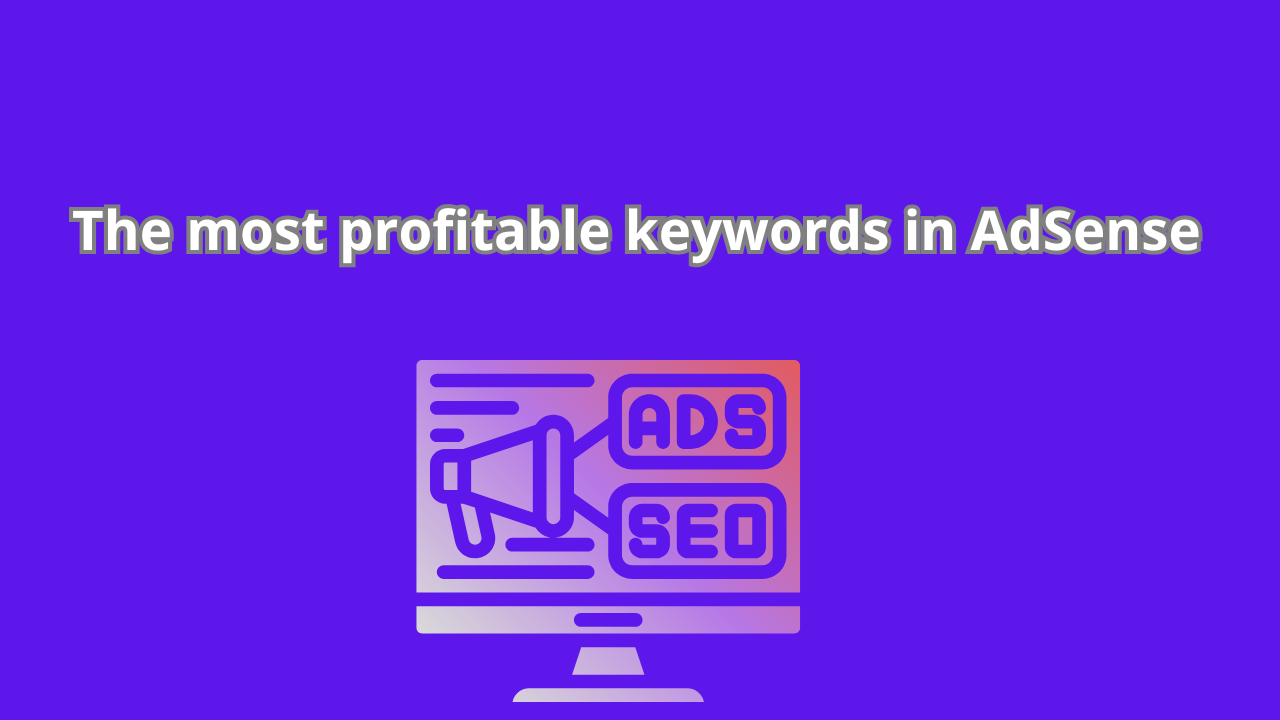The most profitable keywords in AdSense
Google AdSense is one of the most popular platforms for monetizing websites through online advertising. However, not all keywords are created equal when it comes to revenue generation. Some keywords are considered more profitable due to their high competition and the significant value advertisers place on them. Understanding these keywords can help you optimize your content strategy and maximize your AdSense earnings.
The profitability of a keyword is often determined by its Cost Per Click (CPC), which reflects how much advertisers are willing to pay for clicks on their ads. The most profitable keywords in AdSense keywords typically belong to industries or niches where customers have a higher lifetime value or where competition among advertisers is fierce. Examples of these industries include finance, technology, legal services, and health.
In this article, we’ll explore the most profitable keywords commonly used in Google AdSense and provide tips on how to identify and incorporate them into your website content. By targeting high-value keywords effectively, you can boost your website’s ad revenue and take full advantage of the AdSense program.
Understanding High-Value Keywords Google AdSens
High-value keywords are search terms that carry significant monetary value due to their high demand and relevance in specific industries. These keywords are often targeted by advertisers because they attract users who are more likely to convert into customers, making them a critical component of any successful digital marketing strategy.
Identifying and utilizing high-value keywords can help maximize revenue, especially when using platforms like Google Ads or monetizing content through programs like Google AdSense. By creating content that aligns with these keywords, you can attract more targeted traffic and improve your website’s earning potential.
To uncover high-value keywords, conduct thorough keyword research using tools like Google Keyword Planner, Ahrefs, or SEMrush. Look for terms with a high Cost-Per-Click (CPC) and strong search volume. Additionally, focus on creating quality content around these keywords to ensure you attract organic traffic while maintaining user engagement.
Understanding and leveraging high-value keywords allows you to optimize your content strategy, boost ad revenue, and achieve better results in your online marketing efforts.
The most profitable keywords in AdSense
Top Niches for Profitable Keywords in Google AdSense
- Finance and Investment
Topics like personal finance, loans, credit cards, and cryptocurrency attract high-paying keywords. - Health and Wellness
Niches such as fitness, mental health, weight loss, and medical treatments generate valuable keywords. - Technology
Content on software, gadgets, AI, and tech tutorials often yields profitable AdSense returns. - Education and Online Learning
Online courses, certifications, and skill development are highly lucrative topics. - Legal Services
Keywords related to lawyers, legal advice, and law firms are among the highest paying. - Real Estate
Topics like property investment, home loans, and real estate markets drive high CPC. - Insurance
Auto, health, life, and home insurance keywords are consistently profitable. - E-commerce and Online Shopping
Product reviews, comparisons, and affiliate marketing opportunities perform well. - Travel and Tourism
Content about destinations, travel tips, and booking platforms often attracts high-paying ads. - Business and Entrepreneurship
Resources on startups, marketing strategies, and management tools are in demand.
Focus on creating high-quality, engaging content in these niches to maximize your AdSense revenue.
How to search for old keywords by price in Google AdSense
Searching for old keywords by price in Google AdSense is not directly possible, as AdSense primarily focuses on ad placement and revenue generation rather than keyword tracking. However, you can use Google Ads Keyword Planner or analytics tools to analyze keyword performance. Here’s how:
- Access Google Ads Keyword Planner: Log in to your Google Ads account and navigate to the Keyword Planner tool to find historical keyword data.
- Filter by Date Range: Set a specific date range to check old keyword trends and performance within a particular period.
- Analyze Cost-Per-Click (CPC): Use the “Historical Metrics” section to view CPC data for keywords, giving you insights into their price trends.
- Export Data: Download the keyword data for further analysis or comparison with past performance.
- Link Google Analytics: If you have connected Google Analytics to your AdSense account, you can review historical traffic sources and keyword contributions to your revenue.
Using these methods, you can analyze keyword data and assess historical pricing trends indirectly related to your AdSense performance.
Tools for Keyword Analysis and Selection
- Google Keyword Planner
A free tool by Google that helps you find relevant keywords and provides data on search volume, competition, and cost-per-click. - SEMrush
A comprehensive SEO tool that offers keyword research, competitor analysis, and keyword difficulty insights. - Ahrefs
Known for its extensive backlink data, Ahrefs also provides robust keyword analysis tools, including search volume, keyword difficulty, and related terms. - Moz Keyword Explorer
Offers keyword suggestions, difficulty scores, and organic click-through rate (CTR) analysis. - Ubersuggest
A free tool by Neil Patel that provides keyword ideas, search volume, and SEO difficulty metrics. - Keyword Tool
Generates long-tail keyword suggestions based on Google Autocomplete and supports other platforms like YouTube, Amazon, and Bing. - AnswerThePublic
Visualizes keyword suggestions in the form of questions, prepositions, and comparisons, making it ideal for content creation. - KWFinder
A user-friendly tool that specializes in finding long-tail keywords with low SEO difficulty. - Serpstat
An all-in-one SEO platform that includes keyword research, competitor analysis, and market trends. - WordStream Free Keyword Tool
Provides keyword suggestions and performance metrics, tailored for both SEO and PPC campaigns. - Long Tail Pro
Focuses on identifying high-performing long-tail keywords with low competition. - SpyFu
Allows you to analyze competitors’ keyword strategies and uncover high-value keywords in your niche. - Google Trends
Offers insights into keyword popularity and seasonal trends over time. - Soovle
Aggregates keyword suggestions from various search engines like Google, Bing, Yahoo, and Amazon. - Keyword Surfer
A Chrome extension that provides search volume, CPC, and related keywords directly in Google search results.
Using a combination of these tools can help you uncover valuable keywords, analyze competition, and optimize your content strategy effectively.
Incorporating High-Value Keywords into Your Content
Incorporating high-value keywords into your content is a critical aspect of search engine optimization (SEO) that can significantly improve your website’s visibility and ranking. Here’s a step-by-step guide to help you effectively integrate these keywords into your content:
- Conduct Comprehensive Keyword Research
Use tools like Google Keyword Planner, SEMrush, or Ahrefs to identify high-value keywords that are relevant to your niche. Consider factors such as search volume, competition, and relevance to your audience. - Understand Search Intent
Determine the intent behind each keyword. Is the user looking for information (informational), trying to make a purchase (transactional), or searching for a specific website or product (navigational)? Align your content with the appropriate intent. - Incorporate Keywords Naturally
Avoid keyword stuffing, which can harm your rankings. Instead, weave keywords seamlessly into your content, ensuring that it reads naturally and provides value to the reader. - Optimize Key On-Page Elements
- Title Tag: Include your primary keyword in the title to signal relevance to search engines.
- Meta Description: Use the keyword in the meta description to improve click-through rates.
- Headings (H1, H2, H3): Place keywords in your headers to structure your content and improve readability.
- URL: Incorporate the keyword into your page’s URL for better optimization.
- Focus on High-Quality Content
Create content that provides genuine value to your audience. High-quality, engaging, and informative content naturally attracts readers and encourages them to spend more time on your site. - Leverage LSI Keywords
Use Latent Semantic Indexing (LSI) keywords—related terms and phrases—to enhance the context of your content and avoid overusing the primary keyword. - Optimize Images and Alt Text
Include keywords in image file names and alt text descriptions to improve your content’s accessibility and boost SEO. - Internal and External Linking
Link to relevant internal pages using anchor text that includes high-value keywords. Additionally, provide outbound links to authoritative sources for added credibility. - Monitor Performance and Adjust
Use analytics tools to track how your content is performing for specific keywords. If necessary, refine your strategy by incorporating new keywords or adjusting your content for better results.
By implementing these strategies, you can effectively incorporate high-value keywords into your content, driving more traffic to your site while providing a better experience for your audience.
Balancing User Experience with Keyword Optimization
Creating a seamless user experience while integrating effective keyword optimization is essential for a successful digital strategy. Prioritize content that resonates with your audience by crafting informative, engaging, and easy-to-navigate pages. Simultaneously, strategically incorporate relevant keywords in a natural and non-intrusive manner. This approach ensures your content remains accessible and valuable to users while boosting visibility in search engines. Remember, focusing too heavily on keywords at the expense of user experience can detract from your site’s overall effectiveness. Aim for a harmonious blend that serves both your audience and your SEO goals.
conclusion
Maximizing revenue through Google AdSense often involves striking the right balance between ad placement, content relevance, and optimization strategies. One approach some publishers explore is raising the cost-per-click (CPC) by leveraging competitive pressure among advertisers. This can be achieved by creating high-quality, niche-specific content that attracts advertisers willing to pay a premium to target your audience.
Focus on topics with high commercial intent and optimize your site for those keywords, ensuring your content aligns with what advertisers in that niche are seeking. Additionally, experiment with ad placements, sizes, and formats to increase visibility and engagement without overwhelming the user experience. Keep in mind that improving site traffic and maintaining a high-quality audience are crucial factors in driving up CPC rates.
Avoid tactics that could violate Google’s policies, such as artificially inflating clicks or manipulating traffic sources. Instead, prioritize sustainable strategies that enhance both user satisfaction and advertiser interest. By fostering a competitive environment and delivering value to all parties, you can naturally encourage higher bids and improve your AdSense earnings over time.



